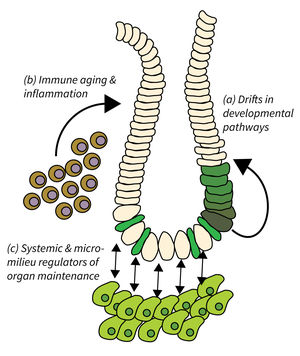Subarea 2: Regeneration and Homeostasis of Organs in Aging
The main goal of Subarea 2 is to identify cellular and molecular pathways used to ensure effective organ maintenance and repair, and to unravel the mechanisms of their deterioration during aging. While stem cells are important for organ homeostasis, this Subarea does not per se directly addresses stem cell aging but rather focusses on the following focus areas:
- Drifts in developmental pathways limiting organ maintenance in aging,
- Immune aging and inflammation, and
- Systemic and micro-milieu regulators of organ maintenance, regeneration, and disease development.
Research focus of Subarea 2
Organ maintenance is regulated by local and systemic factors, which are subject to aging-associated changes. Research of Subarea 2 focuses on the following research areas: a) Genetic and epigenetic modulation of developmental pathways has been shown to contribute to progressive aging and disease. It is critical to delineate mechanisms and consequences of aging-associated drifts to better understand organ maintenance during aging. b) Immunoaging and chronic inflammation elicits negative effects through reduced immune surveillance and aberrant organ repair and maintenance; all of which contributes to the evolution of organ pathologies and diseases during organismal aging. c) Furthermore, aging-associated alterations in systemic and extracellular factors derived from metabolic changes, microbiota alterations, chronic inflammation, senescent, or damaged cells might impinge on disease development and tumor initiation.
Publications
(since 2016)
2023
- Sequencing the Immunoglobulin Heavy-Chain Locus (IgH) in Turquoise Killifish ( Nothobranchius furzeri).
Seidel J, Bradshaw WJ, Valenzano DR
Cold Spring Harb Protoc 2023, 5 - Taxonomic Profiling of Fecal and Intestinal Microbiota in the African Turquoise Killifish Nothobranchius furzeri.
Seidel J, Popkes M, Valenzano DR
Cold Spring Harb Protoc 2023, 2023(10), 755-62 published during change of institution - Corrigendum: Taxonomic Profiling of Fecal and Intestinal Microbiota in the African Turquoise Killifish Nothobranchius furzeri.
Seidel J, Popkes M, Valenzano DR
Cold Spring Harb Protoc 2023, 2023(10), pdb.corr108388 published during change of institution - Peripheral Nerve Ageing Maintenance, repair, and CCL11 as an ageing factor
Stockdale A
Dissertation 2023, Jena, Germany - Cre recombinase expression cooperates with homozygous FLT3 internal tandem duplication knockin mouse model to induce acute myeloid leukemia.
Straube* J, Eifert* T, Vu T, Janardhanan Y, Haldar R, von Eyss B, Cooper L, Bruedigam C, Ling VY, Cooper E, Patch AM, Bullinger L, Schnoeder TM, Bywater M, Heidel* FH, Lane* SW
Leukemia 2023, 37(4), 741 * equal contribution - Immunoproteasome function maintains oncogenic gene expression in KMT2A-complex driven leukemia.
Tubío-Santamaría N, Jayavelu AK, Schnoeder TM, Eifert T, Hsu CJ, Perner F, Zhang Q, Wenge DV, Hansen FM, Kirkpatrick JM, Jyotsana N, Lane SW, von Eyss B, Deshpande AJ, Kühn MWM, Schwaller J, Cammann C, Seifert U, Ebstein F, Krüger E, Hochhaus A, Heuser M, Ori A, Mann M, Armstrong SA, Heidel FH
Mol Cancer 2023, 22(1), 196 - Signalling by senescent melanocytes hyperactivates hair growth.
Wang X, Ramos R, Phan AQ, Yamaga K, Flesher JL, Jiang S, Oh JW, Jin S, Jahid S, Kuan CH, Nguyen TK, Liang HY, Shettigar NU, Hou R, Tran KH, Nguyen A, Vu KN, Phung JL, Ingal JP, Levitt KM, Cao X, Liu Y, Deng Z, Taguchi N, Scarfone VM, Wang G, Paolilli KN, Wang X, Guerrero-Juarez CF, Davis RT, Greenberg EN, Ruiz-Vega R, Vasudeva P, Murad R, Widyastuti LHP, Lee HL, McElwee KJ, Gadeau AP, Lawson DA, Andersen B, Mortazavi A, Yu Z, Nie Q, Kunisada T, Karin M, Tuckermann J, Esko JD, Ganesan AK, Li J, Plikus MV
Nature 2023, 618(7966), 808-17 - Transcriptomes of aging brain, heart, muscle, and spleen from female and male African turquoise killifish.
Xu A, Teefy BB, Lu RJ, Nozownik S, Tyers AM, Valenzano DR, Benayoun BA
Sci Data 2023, 10(1), 695 published during change of institution
2022
- Inhibition of Cdk5 increases osteoblast differentiation and bone mass and improves fracture healing.
Ahmad M, Krüger BT, Kroll T, Vettorazzi S, Dorn AK, Mengele F, Lee S, Nandi S, Yilmaz D, Stolz M, Tangudu NK, Vázquez DC, Pachmayr J, Cirstea IC, Spasic MV, Ploubidou A, Ignatius A, Tuckermann J
Bone Res 2022, 10(1), 33 - Population size shapes the evolution of lifespan
Bagic M, Valenzano DR
bioRxiv 2022









